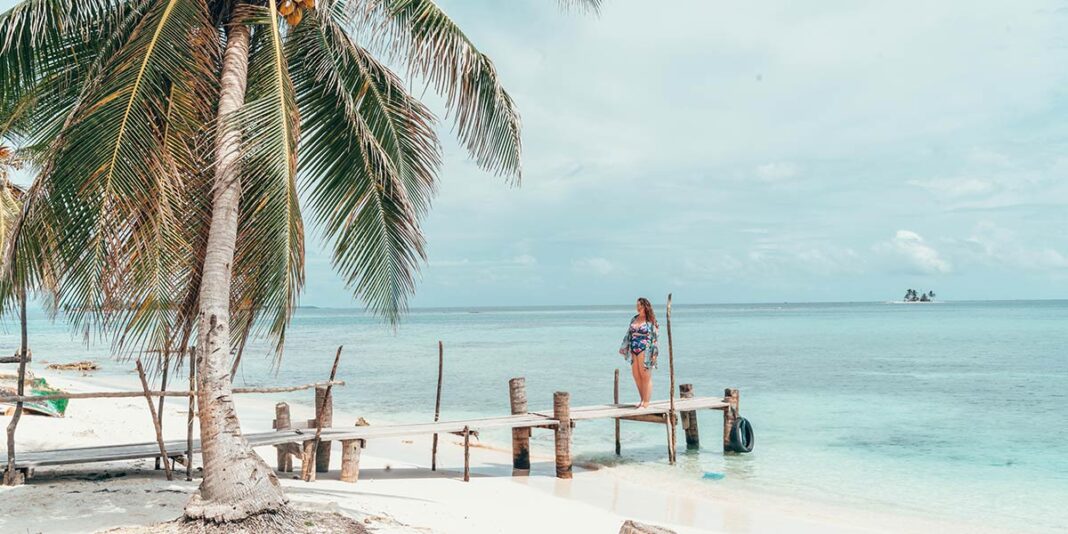
products. Practical Wanderlust and CardRatings may receive a commission from card issuers.
The summer after I graduated college, I took my first independent backpacking trip. I’d won a fashion design scholarship (RIP, my sewing skills pre-blogging) so I decided to use the cash prize to treat myself to 2-week trip across Europe.
I carefully planned my itinerary through 5 European countries (I had so much energy back then…) staying at hostels along the way to stretch my money as much as possible. I intended to be as frugal as I could, knowing that I would need some of that scholarship money to move myself to San Francisco to start my first salaried job.
It was a truly incredible trip which cemented my love for travel and planted the seed which would later bloom into quitting my job to travel and becoming a full-time travel blogger. But having a great trip is a boring story. The real reason I’m sharing this story is because this trip in particular had two major mishaps:
- Mishap #1: Although I planned and paid for the trip all on my own, I brought along my college boyfriend. We then proceeded to break up … during the trip. Like, our breakup spanned the entire two weeks. Half of my memories from that trip are having deep, tearful discussions about the state of our relationship in various beautiful European plazas. Big yikes. Lesson learned: travel can make or break a relationship, and breaking up while traveling is a great way to ruin an otherwise awesome trip. Pick your travel companion carefully!
- Mishap #2: As fresh-faced, 21-year old college graduate, I wasn’t exactly fully versed in international travel. I brought along a Charles Schwab debit card to take out cash from ATMs to pay for everything during my trip. But my travel companion (my boyfriend-turned-ex-boyfriend) brought along a regular, standard credit-union-issued credit card to pay for his share. He used that credit card to get cash out of ATMs, to pay for meals and souvenirs, and to pay for tearful phone calls home to his family and friends to let them know that we were in the process of breaking up. To my horror, I later learned that this ended up costing him hundreds of dollars in ATM fees, cash advance fees, foreign transaction fees, and phone fees. MASSIVE yikes.
To this day, a decade later, I still feel horribly guilty about the way this trip went down for my poor ex. (He later ended up moving to Europe with his wife, and I hope he was able to revisit each and every place we went to make new, less painful memories there.)
But let’s get to the point of this post: that freakin’ credit card. What my ex didn’t realize was that his credit card was only designed to be used in the USA. Every single time he swiped it in another country, he racked up fees.
This was the first time in my life I’d heard of the term “foreign transaction fee.” So in case this is your first time too, let me save you some money: a foreign transaction fee is a surcharge on your credit card bill that appears when you make a purchase that either passes through a foreign bank or is in a currency other than the U.S. dollar (USD). This fee is charged by many credit card issuers, typically ranging from 1% to 3% of the transaction. That means that if you spend $2,000 on an international trip, you’ll be paying anything from $20 to $60. Not so awful, right?
But get this. His credit card also charged a “processing fee” on any purchase made in an international currency. The fee? $10, with an additional $10 fee for items less than $300 USD.
This means that every pack of gum, cup of coffee, train ticket, and souvenir he purchased cost him $20 – PLUS an extra 3% of the purchase price – just in fees. Did your blood just run cold??
Add that $20 and a 3% fee to ATM withdrawal fees, steep cash advance fees (never, ever use your credit card to get cash from an ATM if you can help it, y’all!) and $1-per-minute calls home, and you can see how the cost of the trip quickly sky-rocketed. It still gives me anxiety to think about, and I’m now a fully grown married woman who travels for a living.
But you’re here now, and you’ll never make that mistake. Right?! Please, stop reading and PROMISE ME you’ll never make that mistake, because you are going to bring a credit card on your next international trip that is designed for international travel.
And for cash withdrawal, you are going to use a debit card that has no foreign transaction or ATM fees, like Charles Schwab, and if you can’t do that then you are going to bring US cash with you and visit a currency exchange place as soon as you arrive to get cash to use on your trip, which you will then keep mostly tucked away in your locked suitcase (next to a backup travel credit card) and bring only the amount you’ll need each day secured in a money belt or bra pocket where pickpockets can’t access it (this is a crucial travel safety tip).
Promise me!
Ok. Now that I can breathe a little easier, let’s get into it. In this post, you’ll learn all about my favorite credit card for international travel, why I’ve been using it for the past decade for all of my trips, how it’s save my a** several times when things went sideways, and how I use credit card rewards to help pay for travel (which helped me save up enough money to quit my job and travel for a year – here’s how). Let’s do this!
Heads up! There’s a REALLY epic sign-up bonus for our favorite travel credit card right now that’s worth $1,250 in travel points.
This is actually the best sign-up bonus we’ve ever seen, so … it’s kind of a big deal. I mean, where would you go with $1,250?? (We have some ideas…) Hurry up and snag one before the offer expires!
Psst: Need some more practical travel advice? Take a look at some of our other posts:
Why Chase Sapphire is The Best Credit Card for International Travel
The first credit card I ever signed up for was a Chase Sapphire Preferred. I was fresh off of that fateful backpacking trip and newly salaried, and I wanted to test the waters out with a credit card that would reward me for my purchases – so that I could go travel more (as often as possible, preferably.)
I was immediately swayed by a tantalizing sign-up bonus. At the time, the bonus for new sign-ups was valued at over $1,000 – enough for a round trip international ticket, and them some. I was sold.
But over the years, well after my sign-up bonus was earned and spent, I’ve earned thousands of dollars more in rewards from that same car. It’s not just thanks to its 2x points back on both dining and travel (my two top spending categories after rent).
The biggest benefit I’ve gotten from the Chase Sapphire credit card isn’t the sexiest sounding perk at all: it’s the insurance coverage. (See? Not sexy. Insurance just isn’t sexy, much as I’ve tried to make it alluring with posts like my guide to travel insurance. Which, incidentally, you definitely should not travel without.)
Over the years – and my many, many travel mishaps and disasters – I’ve filed multiple claims with Chase Sapphire, from trip cancellation to rental car auto collision. And I’ve received thousands of dollars back in coverage. So much so that I’m honestly worried they’re going to read this post and be like “um can you stop talking about us, and also maybe stop using our cards? You’re … expensive.”
Oh, and then there’s the lack of foreign transaction fees. And the access to cushy lounges. And the travel portal. You know what? I can’t really summarize it. Let’s break things down, point by point.
✔ No foreign transaction fees.
This is where my story with Chase Sapphire begins, and this is how we found one another. I needed a card that wouldn’t charge me an arm and a leg just for traveling internationally.
Chase Sapphire not only doesn’t have any foreign transaction fees, but they actually REWARD me for traveling! Which brings me to my next point.

✔ 2x points for dining and travel.
After my ludicrous Bay Area rent, my second largest spending categories are dining (cuz hello, I like to eat) and travel (to be fair, it is my job. And most of my dining out is actually travel-related!)
Chase Sapphire rewards me with cash back for all of those purchases, from restaurants to flights to hotels to car rentals and everything in between.
Sometimes I’ll buy food at the airport and find myself thinking, “ooh, which category is this going to be categorized as, dining or travel?” And then I do a little laugh to myself because I’m being a silly billy and either way, I get 2x points, but I’m honestly still curious. I wish I could say this was an exaggeration, but I spend a lot of time sitting around in airports at odd hours of the night, sleep-deprived and delirious. For proof, please watch my Instagram Italy highlight, during which I “sightsee” around the airport terminal at 4 am. In my defense, I had been traveling for 30 hours at that point…
✔ Trip delay, interruption, and cancellation coverage!
We’re no strangers to canceling and delaying our trips. After canceling several months’ worth of travel during our year-long honeymoon due to my grandfather faking his own death (the full, ridiculous story is in this post) only to get back on the road and have to delay our trip again because I got a raging ear infection, we never, ever travel without travel insurance.
But there are times when we forget to purchase a travel insurance plan (we typically buy ours from World Nomads or SafetyWing), or we don’t think we’ll need one because we’re traveling domestically. For those occasions, in the event of a covered issue (like illness, severe weather, etc) Chase covers everything that we’ve booked with our Chase Sapphire card.
Over the years we’ve used this benefit a few times, most recently during a country-wide strike that affected an upcoming trip to France. Because we’d purchase our (non-refundable) flights through Chase, we were able to get them cancelled and refunded – even though the airline wasn’t interested in helping us out. That saved us a couple thousand dollars in refunded flights!
Personally, I still prefer to have both my typical travel insurance policy and my Chase Sapphire coverage to in the event of a mishap, just because each policy covers different things, and having two policies with different coverage gives me some peace of mind that no matter what happens, I’ll be able to get help. I’ve filed claims over the years with both Chase and World Nomads, and they work nicely in tandem!
✔ Primary rental car auto collision coverage.
I think this is one of the Chase Sapphire’s BEST benefits. I truly I can’t tell you how much money this benefit has saved me over the years, but off the top of my head I know it’s at least a few thousand because that’s how much it cost us when we returned a rental BMW with a broken headlight after our disastrous road trip in France. (We also managed to get the BMW stuck inside of a medieval castle, but miraculously, there wasn’t a scratch on it from that mishap. For some reason, France is just a place where we seem to have truly awful luck.)
But even without needing to file a single claim, the benefit saves us hundreds of dollars whenever we rent a car – both domestically and internationally – because we’re able to decline the rental company’s collision insurance. We know that as long as we pay for our rental car with Chase Sapphire every time, we’re fully covered with primary collision/theft insurance – AND getting 2x pack on points for it, too!
Plus, it’s really nice to have a quick way to get out of that inevitable 10-minute long car insurance coverage sales pitch.

✔ Baggage delay & lost luggage reimbursement!
This is another benefit which has come in incredibly handy over the years! A couple of summers ago, we brought a group of my husband’s high school students with us to Colombia for two weeks. For most of his kids, it was the very first time traveling internationally – so imagine how anxious we all felt when THREE of their suitcases – AND Jeremy’s suitcase – were all mysteriously missing upon our arrival at the Bogota airport.
In between running around the airport using my average-at-best Spanish to explain the situation to various helpful airline employees, I tried to reassure everyone that losing that much baggage is actually not typical.
But all in all, it took three days for the missing luggage to turn up. Three days for high school students in a foreign country on their first-ever international trip is a LONG TIME to be without their clothing, toiletries, and other personal belongings.
Luckily, we were covered by baggage delay, which provides up to $100 per day for five days to go towards essential purchases like toiletries and clothing. So Jeremy took the kids on a little mini shopping spree in a Colombian department store. Their anxiety was mitigated by the excitement of buying new stuff, and Jeremy actually got a really cute outfit that is still one of his favorites!
Even if the baggage had not eventually turned up, Chase Sapphire also provides lost luggage reimbursement, which covers both damaged and lost check-on and checked luggage up to $3,000. Which, frankly, is more than my entire wardrobe at home is worth.
We’ve never had to use it, but honestly? I wouldn’t be made about having to go buy a whole bunch of new stuff, especially somewhere with really good shopping. ..OK. I don’t want to challenge the Universe, especially with my travel disaster record, so let me make this very clear: I’m just kidding! Ha ha! Hilarious joke, me!
✔ Multiple ways to use your points to pay for travel.
You know those 2x points I mentioned for dining and travel? They’re called Ultimate Rewards, and when you travel & eat out as often as I do, they add up fast. And there are a few great ways to use them to pay for travel.
The best way is to spend them in the Ultimate Rewards Portal, which is basically an online dashboard where you can spend your points on all kinds of stuff. The best way to maximize your return is to spend them on travel (including flights, cars, hotels, and more) which you can book directly through the portal! When you book travel in the portal, your points stretch further and are worth 25% more.
When I first got my Chase Sapphire card, I used my sign-up bonus in the Ultimate Rewards portal and was able stretch my points to cover a round-trip flight to Cartagena, Colombia – AND a hotel room.
Another benefit I use frequently is the ability to transfer points to other airline rewards programs. I transfer a lot of my points to Southwest Rapid Rewards, because I live near a Southwest hub and book most of my domestic flights on Southwest – and it’s usually easy to find a Southwest flight for a relatively low number of points. On the vast majority of my domestic flights, I fly Southwest and pay with points earned from either flying other Southwest flights (or my Southwest Airlines credit card) or transferred over from Chase Ultimate Rewards.
The easiest way to use your points, though, is just to pay yourself back for qualifying purchases using cash back. The categories that you can redeem points on rotates regularly, and you won’t always get as good of a points deal, so make sure you do a little bit of math to see what your points are valued at for each transaction.
Typically, the best way to make the most of your Ultimate Rewards points is to transfer them to a travel partner or to book travel with them, but there are promotions from time to time that change that valuation – though to be fair, it may only be credit card rewards hoarders like me, with a spreadsheet full of my point values on each of my cards, who pay that much attention to whether a point is worth $1 or $1.25. This guide has some great tips on maximizing Ultimate Rewards point values.
✔ A whole bunch more benefits that I use frequently (and even more that I don’t)
This post would be a whole lot longer if I went over every single benefit that Chase Sapphire, but there are a few more that I want to call out before I wrap things up.
- 5x points on Lyft. Living in the San Francisco Bay Area where Lyft rides, bikes, and e-bikes are a genuine form of public transportation, this is huge. I use Lyft all the time, and I get both discounts and points back on all of my Lyft rides!
- Travel & emergency assistance, including roadside assistance. Lost, stranded, panicking? Chase will help.
For all of that, you’ll pay a $95 annual fee, which I find more than pays for itself in points, insurance coverage, and other benefits.
And now you know why the Chase Sapphire Preferred card has a permanent place in my bra pocket (after the year-long honeymoon, I never went back to using regular wallets, and now it’s been too long to stop).
Plus, this card is hard to lose even for someone as forgetful as me, because it’s like … thicc. I think it’s made from metal? Anyway, it’s definitely the most epic card in my bra-cket, for multiple reasons.
But there’s one more card that’s at the top of my travel credit card list: the Chase Sapphire Reserve. I know the name is super confusing because they rhyme and it kinda just sounds like the same card, but it is different. It’s like, ~fancier.
Let’s talk about why you might want to opt for the Reserve instead of the Preferred.

Chase Sapphire Reserve vs Preferred
A few years after I got my first Chase Sapphire Preferred card, they came out with an even better card: the Chase Sapphire Reserve.
This version of the Chase Sapphire card offers all of the above benefits of the original card, but with even better points bonuses and more fantastic travel benefits, including:
✔ 3X points on dining and travel, so you can guarantee I’ll always be the one offering to put dinner on my card and get everyone else to Venmo me.
✔ 10x points on Lyft, so I never have to drive anywhere again.
✔ 50% points bonus when booking travel through the Ultimate Rewards portal
✔ Free Priority Pass membership, which lets you access boujie airport lounges all over the world – which I looooove on long travel days! Lounges are one of my favorite long-haul flight survival tips.
✔ $300 annual credit back on travel expenses. It gets applied automatically when you book travel on your card, and it really helps pay for the annual fee.
For all those bonuses, you’ll pay a $550 annual fee. I know that sounds like a whole lot, but when you subtract the $300 travel credit, you really only need to earn back $250 worth of points to make the card worth it, which I find fairly easy to do as a frequent traveler and restaurant-goer!
The 100k Sign-Up Bonus
In June 2021, Chase Sapphire announced its highest EVER sign-up bonus for new cardholders: 100k points after spending $4,000 in the first 3 months after account opening. If you redeem those points through the Ultimate Rewards portal, they’re worth $1,250.
I mean, y’all: that’s a whole-a** international flight. Or a couple of domestic ones. Or maybe a baller stay at a resort. Like, what would you do with $1,250? I have a lot of ideas…
Nobody knows how long this bonus is slated to last, so my very strong recommendation is to not miss out. Go snag this card ASAP, or you’ll probably end up with a strong case of FOMO for a really long time (yes, I speak from much experience.)
So, now you know why you absolutely cannot just bring any old credit card along with you on your next international trip, and you know all about my favorite travel credit card, the Chase Sapphire Preferred (or the Chase Sapphire Reserve if you’re fancy).
But there’s one more thing: there’s a REALLY epic sign-up bonus on this card right now (as of June 2021) so hurry and snag one before the offer expires! This is actually the best sign-up bonus they’ve EVER offered, and it’s worth $1,250 in travel points in the Ultimate Rewards portal. Where would you go with $1,250? Drop me a comment below!
Psst: looking for more travel tips? Check out a few of our other posts:

FOLLOW US!
Disclaimer: Practical Wanderlust has partnered with CardRatings for our coverage of credit card
products. Practical Wanderlust and CardRatings may receive a commission from card issuers.
Get the FREE Travel Planning Guide

Need some help planning your next adventure? Our FREE 25-page Travel Planning Guide includes everything you need to plan a trip, plus 5 printable packing lists. We’ll also send our favorite travel tips straight to your inbox!
Our Top Travel Tips & Resources
- Booking Flights: To score flight deals, search on Skyscanner or Kayak. Money-saving tips: fly mid-week or on the weekend; fly carry-on only on a budget airline; and take red-eyes or early morning flights.
- Accommodations: We usually stay in budget-friendly, vacation rentals, boutique hotels or private rooms in hostels. We use Booking.com to book hotels (we love their flexible cancellation policy) and Hostelworld to book hostels (low deposit, easy change/cancellation, and excellent reviews). For vacation rentals, we prefer to book using VRBO (they’ve got lower fees and better support than Airbnb, and we’re not fans of Airbnb’s unethical track record.) You can also book vacation rentals on Expedia and Hotels.com. We’ve also used TrustedHousesitters as both hosts (for our home and our fur-child) and travelers!
- Travel Insurance: We always, always, ALWAYS buy travel insurance for international trips, and we STRONGLY suggest it – visit our Travel Insurance Guide to find out why. We recommend either World Nomads or SafetyWing for international travel insurance. SafetyWing is one of the few policies that covers Covid-19, and they have excellent monthly policies that are perfect for Digital Nomads and long term travelers!
- Vaccines & Meds: We use the travel guides on the CDC website to research recommended medications and vaccines for international trips. We always recommend getting every vaccine recommended by the CDC! You can get them at your primary care doctor’s office or a walk-in pharmacy.
- Tours: We love booking guided tours, especially food tours and walking tours, to get a local’s perspective and a history lesson while sight-seeing! We book our tours using Viator and GetYourGuide.
- Transportation: We use Rome2Rio to figure out how to get from place to place using public transit. When we book a rental car, we use Kayak to compare rental companies and find the best deal.
- Luggage Storage: Whenever we’re checking out early or taking advantage of a long layover, we use Stasher or LuggageHero to safely store our luggage while we’re running around. On Stasher, you can use the code PW10 for 10% off your booking!
- What to Pack: Here are the travel essentials that we bring on every trip. We also have packing lists for hot weather, cold weather, and many more. Take a look at all of our packing guides!
There has never been a better time to plan your next trip and make your Dream vacation a reality . Whether you've been dreaming of relaxing on a sun-kissed beach, exploring ancient cities, or embarking on an epic adventure, now is the perfect moment to make it happen.















